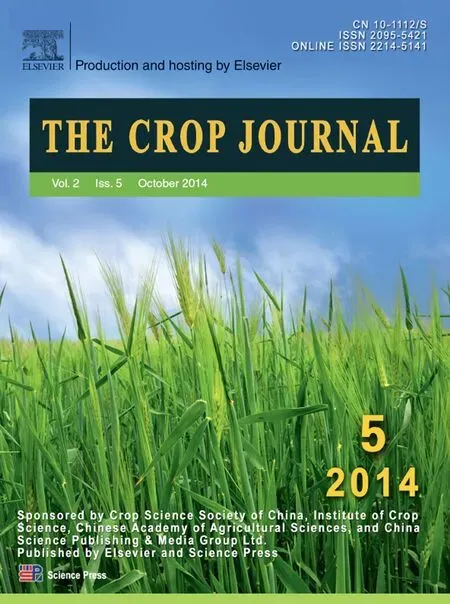Effect of subsoil tillage depth on nutrient accumulation,root distribution,and grain yield in spring maize
Honggung Ci,Wei M,Xiuzhi Zhng,Jieqing Ping,Xiogong Yn,Jinzho Liu,Jingho Yun,Lihun Wng,*,Jun Ren,*
aInstitute of Agricultural Resource and Environment,Jilin Academy of Agricultural Sciences,Changchun 130333,China
bInstitute of Crop Science,Chinese Academy of Agricultural Sciences,Beijing 100081,China
cDepartment of Agronomy,Purdue University,915 W State Street,West Lafayette,IN 47907,USA
1.Introduction
Northeast China is the largest spring maize production area in China.In 2011,the spring maize area in northeast China was 12.53 million hectares,accounting for 37.3% of the national spring maize planting area.The overall yield of spring maize in this area was 80.07 million tons,accounting for 41.5% of the national yield [1].Spring maize in the northeastern region is almost completely rain fed and the main factor limiting the yield is lack of soil water [2,3].At present,its farming system of long-term continuous cropping is dominated by small-sized four-wheeled tractors,which are used for stubble removal,soil preparation,sowing,fertilization,cultivation,and other operations [3,4].However,owing to years of overexploitation of the soil as well as improper mechanical manipulation of the soil,the effective topsoil depth has gradually decreased and the plow pan has thickened [5,6].The average effective topsoil depth is only 15.1 cm in northeast China (against an average of 16.5 cm in China) [7],much smaller than that in North America,which reaches 35 cm on average [7].The shallow and compacted topsoil not only restricts the root development of plants,but hinders their absorption of nutrients and water.The poor soil properties also reduce their tolerance to abiotic stress,especially resistance against natural disasters[5,8].
Subsoil tillage is one of the most effective ways to break up a plow pan in farming management [9–11].It can break up compacted layers,loosening the soil and deepening the topsoil without inverting it,increasing soil permeability [12].As reported by many authors,subsoil tillage can play important roles in efficiently breaking up the plow pan[9,13],promoting water storage in the soil [14,15],adjusting the proportion of solid,liquid,and gas of soil,improving the structure and characteristics of topsoil[15–18],and improving the ecological environment for root development and root activities that enhance the anti-stress capacity of plants[19–21].Varsa et al.[22] concluded that deeper tillage could result in higher corn grain yield,especially in dry seasons.Currently,the time and method for subsoil tillage vary in different regions based on local production operations and included inter tillage [23–25],autumn tillage [26,27],and spring tillage [26–28].In northeastern China,most farmers are accustomed to inter tillage,which is integrated with fertilizer topdressing at the V6 or V7 stage.Wang et al.[5]developed a technique of subsoil inter tillage and water conservation in maize production with high yield and high efficiency.Based on this technique,a local standard was established (DB22/T1237-2011).However,most studies have been performed over only one or two years,with subsoil tillage depths mainly around 30 cm,and the results could not accurately reflect the contribution of the technique to grain yield and nutrient accumulation.
In the present study,a four-year(2009–2012)experiment in the middle region of northeastern China was conducted to evaluate the impacts of different subsoil tillage depths on soil properties,nutrient (N,P,K) uptake,root morphology,and grain yield of spring maize.The aim was to characterize the effects of subsoil tillage on spring maize and thereby provide useful guidance for soil management coupled with appropriate machinery operations for sustainable crop production in the northeastern region.
2.Materials and methods
2.1.Site description
The experiment was conducted on the research farm of Jilin Academy of Agricultural Sciences,Gongzhuling city,Jilin province (43°29′55″N,124°48′43″E) during 2009–2012.The field had been under continuous conventional maize management for many years before the experiment.During the maize growth season,the meteorological parameters were as follows:average temperature was 19.6 °C,frost-free days were 125–140 days,effective cumulative temperature was 2600–3000 °C,and total sunshine hours were 1220 h.The properties of the black soil in the 0–20 cm plow layers were as follows: organic matter,26.4 mg kg-1; available nitrogen,244 mg kg-1; available phosphorus,35.9 mg kg-1; available potassium,140 mg kg-1; and pH 6.59.The precipitation totals during the maize growing seasons in the years 2009–2012 were 234.2,628.2,320.6,and 519.3 mm,respectively.
2.2.Design of experiment
Three tillage treatments were established,consisting of conventional soil management (CK),subsoil tillage to 30 cm depth (treatment T1),and subsoil tillage to 50 cm (treatment T2).The experiment was laid out in a randomized block design with four replicates of each treatment,and each plot was of 140 m2.Conventional soil management was ridge tillage,a long-term continuous maize system,which is dominated by small-sized four-wheeled tractors for soil preparation before sowing.Subsoil tillage was performed with a subsoiling chisel plow in combination with inter tillage in mid-to-late June(V6 stage).Three treatments were applied with basal fertilizer,which comprised 90 kg ha-1N,90 kg ha-1P2O5,and 90 kg ha-1K2O.Pure nitrogen of 135 kg ha-1was added at the 6-expanded-leaves stage (urea with N 46%),phosphate fertilizer as diammonium phosphate (18-46-0),and potassium chloride (K2O 60%).Maize was overseeded on April 25,2009,April 24,2010,April 26,2011,and April 25,2012.At the V3 stage,seedlings were thinned to a density of 60,000 plants ha-1,which is the optimum density for maize hybrids grown in the experimental area.The hybrid was Xianyu 335,which was harvested on September 25,2009,September 24,2010,September 26,2011,and September 24,2012.The experimental area was kept free of weeds,insects and diseases with chemicals based on standard practices.No irrigation was applied.
2.3.Test items and methods
Soil samples from the 0–20 cm plow layer were collected before sowing and conventional chemical methods for determining soil nutrient content were used.At the stage of maize physiological maturity,three representative maize plants for each treatment were collected; leaves,stalks,kernels and cobs were divided,dried and crushed;and N,P and K contents for each fraction were determined.Total N content was determined by the micro-Kjeldahl method,total P content was obtained with method of molybdenum–antimony–D-iso-ascorbic-acidcolorimetry (MADAC) and total K content was tested by flame photometry[29].The middle two rows of each plot were harvested at maturity and grain yield was corrected to 14%moisture content.
A maize root sample was dug with the section sampling method.At the 12-leaf stage (July 4) and early filling stage(August 3),three plants with uniform appearance were selected from each plot for root sampling.Boundaries were separately defined based on the area occupied by each plant,with row distances of 65 cm and plant spaces of 26 cm.Soil and root samples were collected from each 10-cm layer to 80 cm depth.All roots in each soil layer were carefully removed and rinsed with water to remove adhering soil.A 0.05 mm sieve was used to prevent the loss of fine roots during washing.Roots were placed into a zip-locking bag to soak up water and stored at-20 °C.The roots in each layer were scanned with a scanner (Epson V700,Germany) to an image file.The WinRhizoPro5.0 software (Pro2004b,Canada)was used to evaluate root length,surface area,and diameter.The root dry weight of each layer was evaluated after oven drying at 70 °C to constant weight.
At the 12-leaf and early filling stages,soil samples from the soil layers were collected,and treated with 0.01 mol L-1CaCl2.A TRACCS2000 continuous flow analyzer was used to determine the ammonium and nitrate nitrogen contents of the soil.The Olsen method was used to test readily available phosphorus of the soil and the water content was also measured at the 12-leaf stage [29].A soil hardness tester (Yamanaka type,Japan) was used to measure the soil compaction of the 0–80 cm soil layer at the 12-leaf stage.
2.4.Data analysis
Microsoft Excel 2007 software was used for data processing and drawing,and SAS 8.0 statistical software was used for variance analysis and multiple comparisons.
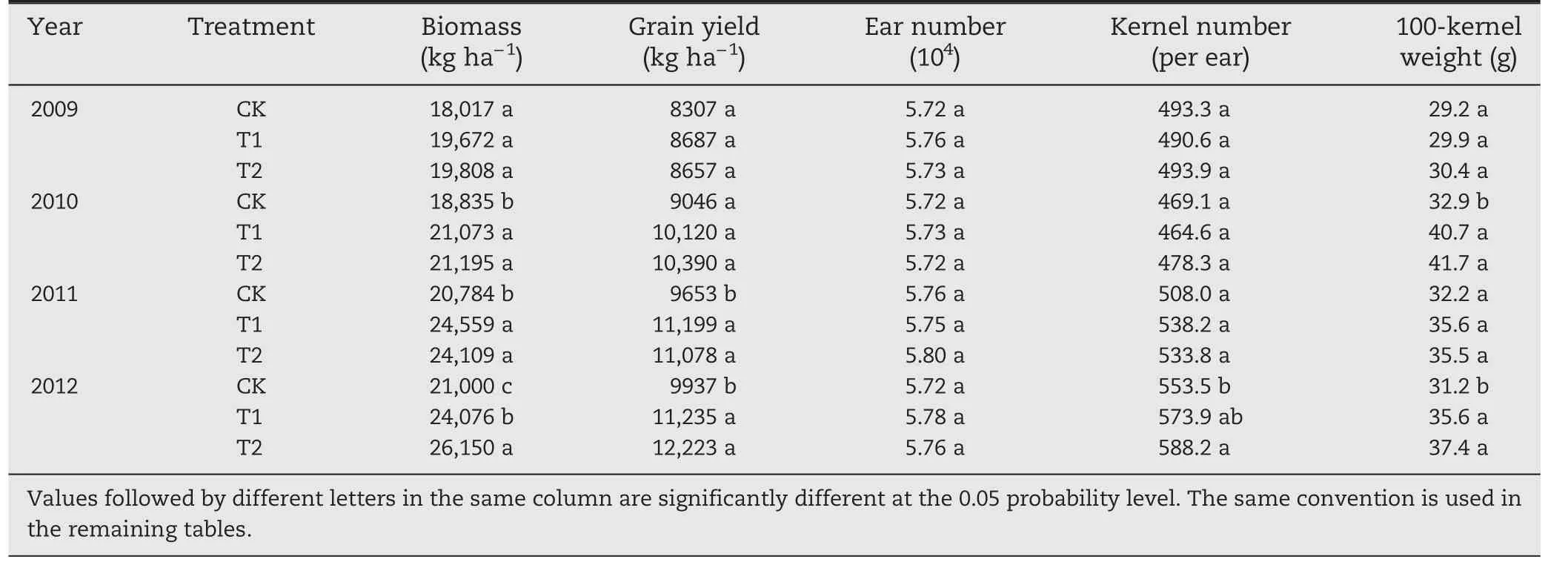
Table 1-Biomass,grain yield,and yield components under different subsoiling treatments.
3.Results
3.1.Dry matter accumulation and yield in maize
Significant differences in biomass and grain yields were found among the three treatments (Table 1).Under the T1 and T2 treatments,grain yields were increased by 4.2–23.0% with an average of 12.8%and dry biomass was increased by 9.2–24.5%with an average of 14.6%.Based on the yield components,subsoiling was responsible for an increase in grain weight,which,comparing T1 and T2 treatments with the control(CK),were increased by 12.7%and 15.2%,respectively.The number of ears was increased by-0.2–0.7% with an average of 0.4%compared with the control (CK).The kernel number was increased by-0.5–6.3%with an average of 2.7%.There was no significant difference between T1 and T2 treatments.
Environment(year)had a significant effect on biomass and grain yield and the interaction between year and treatment was also significant (Table 2).There were significant differences in precipitation and rainy period during 2009–2012(Fig.1),which influenced mainly the slight annual differences in yield components.Although rainfall was sufficient in early 2009,the grain weight was reduced by severe drought in later months of that year,resulting in no significant difference between treatments.Heavy precipitation events occurred mainly in late 2010,resulting in lower kernel number and significantly higher grain weight.Under the T1 and T2 treatments,grain weights were increased by 23.7 and 26.7%,respectively,compared to CK treatment.Grain yield and biomass showed a slight difference between treatments owing to increased rainfall in July and August,masking the effect of subsoil tillage.Although precipitation was abundant throughout the development period in 2012,there was severe lodging caused by Typhoon “Bolaven” at the end of August.Grain filling was thereby affected and 100-kernel weight was reduced,in particular under the CK treatment.It was concluded from the results of the four-year experiment that there were no significant differences between different subsoiling depth treatments with respect to dry biomass,yield,or yield components.However,significant differences were observed in 2012,when dry biomass and yield for subsoil tillage to 50 cm were increased by 8.6%and 8.8%respectively,compared with subsoil tillage to 30 cm.
3.2.Maize nutrient uptake
As with grain yield and biomass,the year also affected N,P,and K accumulations,and there was significant interaction between year and subsoil tillage treatment (Table 2).Drought inhibited the accumulation of N,P,and K in plants,resulting in lower uptake by plants in 2009.In 2010,the nutrients in soil moved down with heavy rainfall in July and August,leading to reduced N and K absorption by the plant.With respect to nutrient distribution,the increased N and P accumulation under T1 and T2 treatments were dominated by grain(Table 3).Compared to CK,N accumulation in kernels under subsoiling treatments increased by 11.4–29.1% with an average of 16.9%,whereas P accumulation in the grains increased by an average of 10.7%,ranging from 2.0 to 31.9%.Interestingly,there was only a slight difference in K accumulation among the three treatments.Although K accumulations in straw in 2010,2011,and 2012 under subsoil tillage(T1 and T2)were higher than those in CK,there was no significant difference in the grain among the three treatments.N,P,and K accumulations of the maize plant under T1 and T2 treatments were both significantly higher than those under CK treatment in 2010,2011,and 2012 except for the P accumulation in 2012 (P <0.05),which increased by 9.9–22.1%,1.7–20.5%,and 2.1–25.5%,respectively.
The N,P,and K accumulations under subsoil tillage up to 50 cm increased by 2.7-2.8%,5.0-8.3%,and 1.6-5.2%,respectively,compared to nutrient accumulation under subsoiling to 30 cm,but there were no significant differences between two treatments.With respect to nutrient distribution,the N,P and K contents in the straws under subsoil tillage to 50 cm increased by 4.0%,-1.7%,and-0.7% respectively,compared to those under 30 cm depth;the N,P,and K content in grains under subsoil tillage 50 cm increased by-1.7%,0.2%,and 1.8%respectively,compared to those under 30 cm depth,but no significant differences were detected between two treatments(Table 3).

Fig.1-Climatological data(active monthly cumulative temperature and precipitation)for the 2009,2010,2011,and 2012 maize growing seasons.
3.3.Root morphological characteristics around flowering
The subsoil tillage had no significant effect on root morphology,especially after flowering (Figs.2–5).At the V12 stage,total root length,root surface area,root diameter,and root dry weight in 0–80 cm soil under subsoil tillage treatment increased by 22.9–23.9%,13.9–17.8%,7.4–26.1%,and 1.2–8.8%compared to those under CK treatment.However,at early filling stage,total root length,root surface area,root diameter,and root dry weight in 0–80 cm soil in subsoil treatment were higher than those in CK treatment,with differences of 43.8–49.8%,28.8–36.5%,13.3–21.3%,and 9.1–13.3% compared to those of CK treatment.Between subsoiling depths there were no significant differences in root length,surface area,diameter,or dry weight,but there were significant differences between some soil layers at different depths,especially in deeper soil layers.
At the 12-leaf stage,the maximum root length was recorded in the 0–10 cm soil layer under CK treatment and was significantly greater than those in subsoil tillage treatments; as deeper soil was sampled,total root length decreased under CK treatment.For example,the root length in the 40–80 cm soil layer accounted for only 9.7%of total root length and was significantly less than those under T1 and T2 treatments (Fig.2).The maximum percentage for the root length reached 19.6% under subsoil tillage to 50 cm,significantly greater than that under subsoiling to 30 cm.Also,at the early filling stage,root length in the 40–80 cm soil layer accounted for 27.3% of the total length under subsoiling to 50 cm.Significant differences were found among the three treatments.
The distribution of root surface areas in different soil layers was correlated with root length (Fig.3).At the 12-leaf stage,the distribution of root surface areas in different soil layers were as follows: in the CK treatment,66.0% for the 0–20 cm soil layer,21.1%for the 20–40 cm soil layer,and 12.9%for the 40–80 cm soil layer;for the T1 treatment,57.1%for the 0–20 cm soil layer,28.3%for the 20–40 cm soil layer,and 14.6%for the 40–80 cm soil layer;for the T2 treatment,52.0%for the 0–20 cm soil layer,29.1%for the 20–40 cm soil layer and 18.9%for the 40–80 cm soil layer.At the early filling stage,the root surface areas from the 40–80 cm soil layers had increased,in the order T2 >T1 >CK.

Table 3-Characteristics of nutrient accumulation and distribution in maize under different subsoiling treatments(kg ha-1).
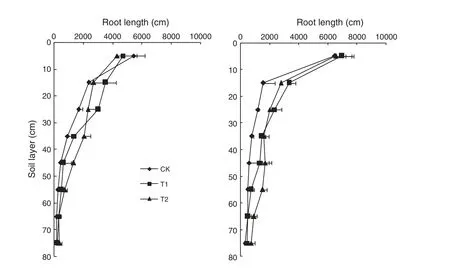
Fig.2-Root length in the 0-80 cm soil layer under different subsoiling treatments.Left:12-leaf stage;right:early filling stage.
The trend of proportions of root dry weights in different soil layers was consistent with those for root length and root surface area.But the proportion of root dry weight in the top soil layer (0–20 cm) was higher and the root dry weight in deeper soil layers was lower (Fig.4).At the 12-leaf stage,the percentages of root dry weights in various soil layers were as follows: for CK,72.2% in the 0–20 cm soil layer,17.5% in the 20–40 cm soil layer,and 10.3% in the 40–80 cm soil layer,for subsoiling to 30 cm,66.0% in the 0–20 cm soil layer,20.9% in the 20–40 cm soil layer,and 13.1% in the 40–80 cm soil layer;for subsoiling to 50 cm,60.9%in the 0–20 cm soil layer,22.8%in the 20–40 cm soil layer,and 16.2% in the 40–80 cm soil layer.At the early filling stage,the percentages of root dry weights in the 0–20 cm soil layers under CK,T1 treatment and T2 treatment increased to 82.1%,75.1%,and 74.0%,respectively,but decreased to 8.5%,10.0%,and 12.5%,respectively,in the 40–80 cm soil layer.The percentages of root dry weights also decreased in the 20–40 cm soil layers.
Based on the comparisons among different treatments,the maximum value for root dry weight was found in the 0–10 cm soil layer under the CK treatment at the 12th leaf and early filling stages,10.6–31.2%greater than those under the T1 and T2 treatments.Significant differences were observed among the three treatments.For the soil layers in the three treatments,the deeper the subsoiled layer,the lower was the root dry weight; however,the root dry weight in CK treatment began to be significantly lower than those under the T1 and T2 treatments in the 30-cm soil layer.No significant differences were found between the root dry weight in the 0–40 cm soil layer under the T1 and T2 treatments,though that under the T1 treatment was slightly higher than that under the T2 treatment.The maximum root dry weight was identified in the 40–80 cm soil layer under the T2 treatment,and was 15.2% and 20.9% higher than those under the T1 treatment at the 12th leaf stage and early filling stages,respectively.There were significant differences between treatments at the early filling stage(Table S1).
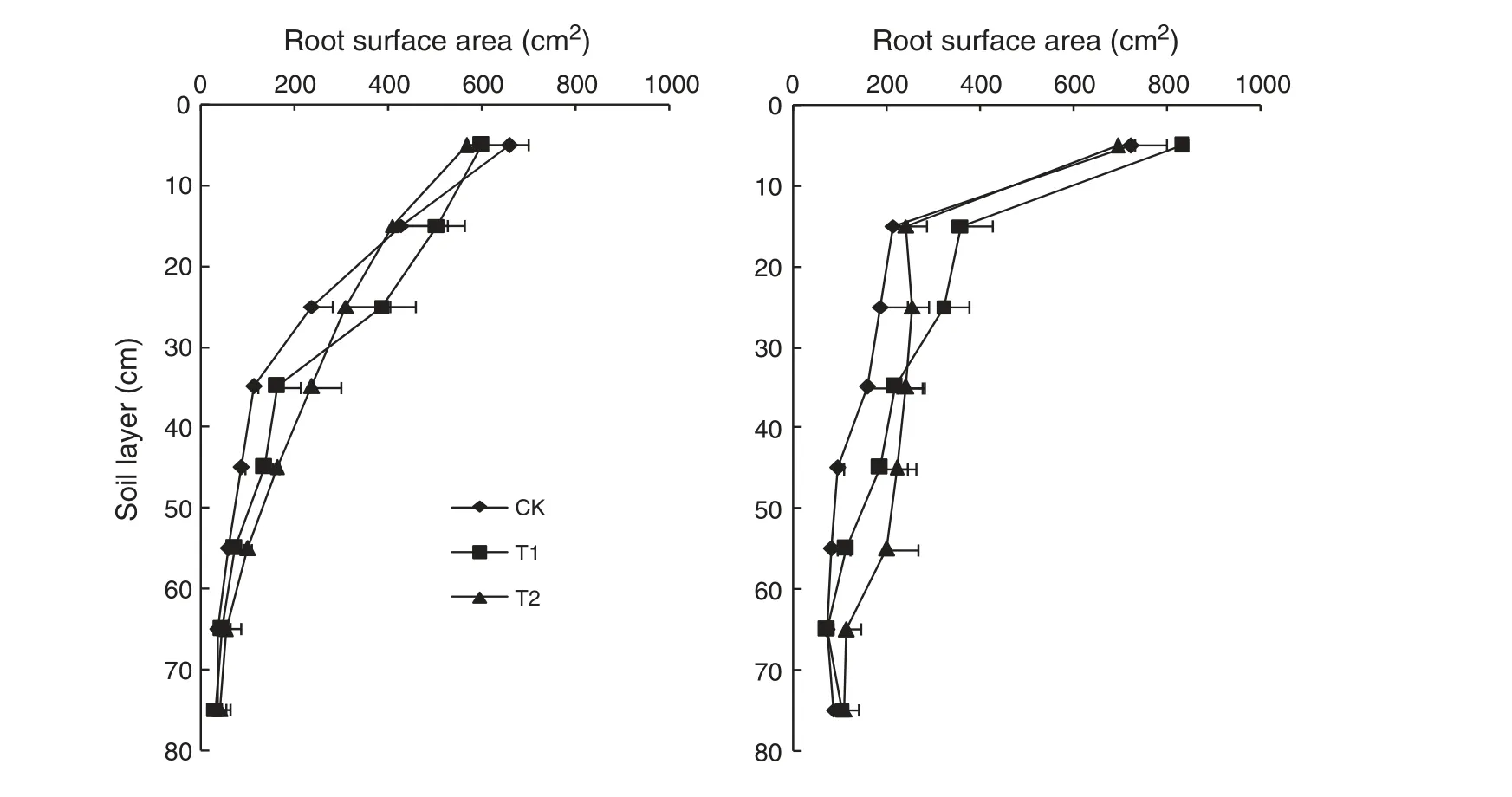
Fig.3-Root surface area in the 0-80 cm soil layer under different subsoiling treatments.Left:12-leaf stage;right:early filling stage.
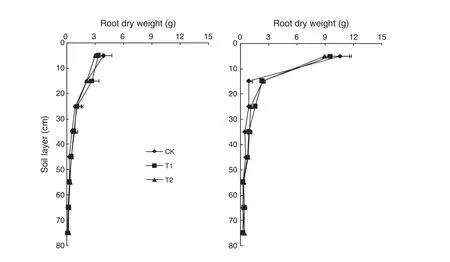
Fig.4-Root dry weight in the 0-80 cm soil layer under different subsoiling treatments.Left:12-leaf stage;right:early filling stage.
Root diameter is an important root morphological parameter and reflects soil influence on the root system.The maximum root diameter under the three treatments was found in the 0–10 cm layer (Fig.5).The root diameter decreased with increasing soil depth.In the top soil layer,the maximum root diameter was found under the CK treatment; in the soil below 20 cm,the maximum value was found under the T2 treatment; at the 12-leaf stage,the variations among root diameters in the 0–80 cm soil layer under the CK,T1 and T2 treatments were 23.7%,13.8%,and 10.0%,respectively.At the early filling stage,the variations were slightly higher,with values of 28.4%,16.9%,and 11.3%for the CK,T1,and T2 treatments.The smallest variation was found under subsoiling to 50 cm,suggesting that subsoiling efficiently breaks up the plow pan,reduces soil resistance to root penetration into deeper soil layers,and promotes root downward growth and uptake of water and nutrients in deeper soil.
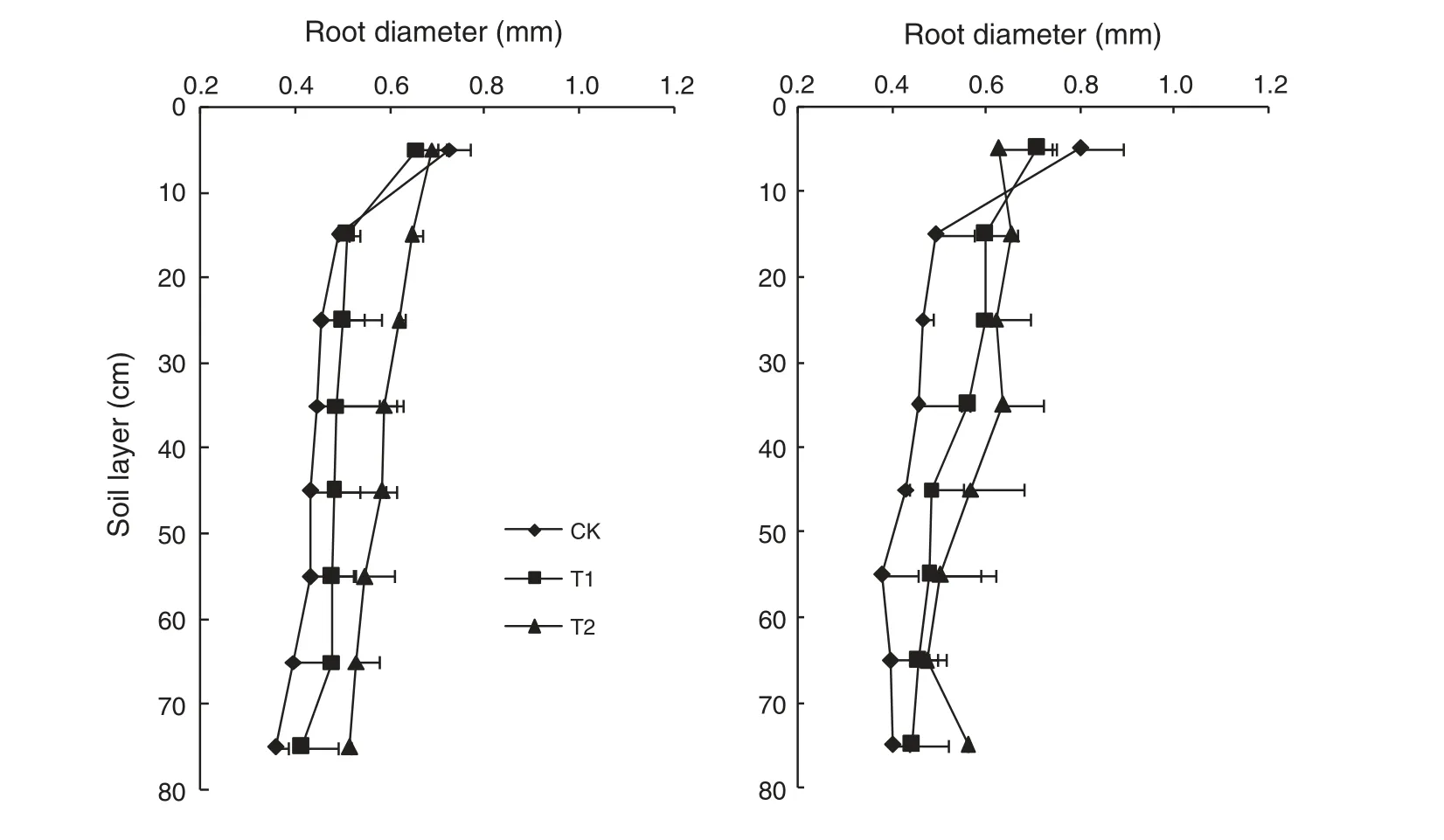
Fig.5-Root diameter in the 0-80 cm soil layer under different subsoiling treatments.Left:12-leaf stage;right:early filling stage.
3.4.Soil physicochemical properties
Significant differences in soil compaction in different soil layers across different subsoiling treatments were found(Table 4).Under the CK treatment,lower compaction was found in the 0–10 cm soil layer,but soil compaction significantly decreased in the 10–20 cm soil layer; under the T1 treatment,lower compaction was found in the 0–20 cm soil layer and the soil compaction began to increase significantly below the 30 cm soil layer.Under the T2 treatment,soil compaction gradually increased with soil depth and remained stable to the 40–50 cm soil layer.There was a significant difference in soil compaction between subsoil tillage management and conventional management in the top 0–40 cm soil layer,indicating that subsoiling efficiently breaks up the plow layer and loosens the soil.Thus subsoil tillage management helps reduce soil compaction in deep soil,in turn facilitating plant growth and development.
After subsoil tillage,the soil was less compact and water content was significantly increased (Fig.6).At the 12-leaf stage,the maximum water content in the 0–40 cm soil layer was found under the T1 treatment,whereas the maximum water content in the 40–80 cm soil layer was found under the T2 treatment and there were significant differences between the CK and T2 treatments.In the 0–80 cm soil layer,the water content of each soil layer under the T1 and T2 treatments was 6.1%higher in average than that under the CK treatment.The difference was increasingly significant with soil depth.At the early filling stage,the advantages of subsoiling were more significant.In the 0–80 cm soil layer,the water contents for the T1 and T2 treatments were both significantly greater than that for the CK treatment.In the 0–80 cm soil layer,the maximum was found under the T2 treatment,and the average water contents under the T1 and T2 treatments were respectively 7.7% and 6.5% greater than that under the CK treatment.
The total amounts of mineralized N and readily available phosphorus in the 0–80 cm soil layer showed no significant differences across treatments (Fig.7).However,the nutrient distribution in each soil layer differed.Under CK treatment,mineralized N accumulated mostly in the top 0–20 cm soil layer,whereas under the T1 and T2 treatments,soil N mineralization decreased with increasing depth.In the 20–40 cm soil layer,the mineralized N content under subsoiling treatments was markedly higher than that under CK treatment at the 12-leaf stage.In the 40–80 cm soil layer,although the maximum mineralized N content was found under subsoil tillage,no significant differences were found among the three treatments(Fig.7).

Table 4-Soil compaction in the 0-80 cm soil layer under different subsoiling treatments(kg cm-2).
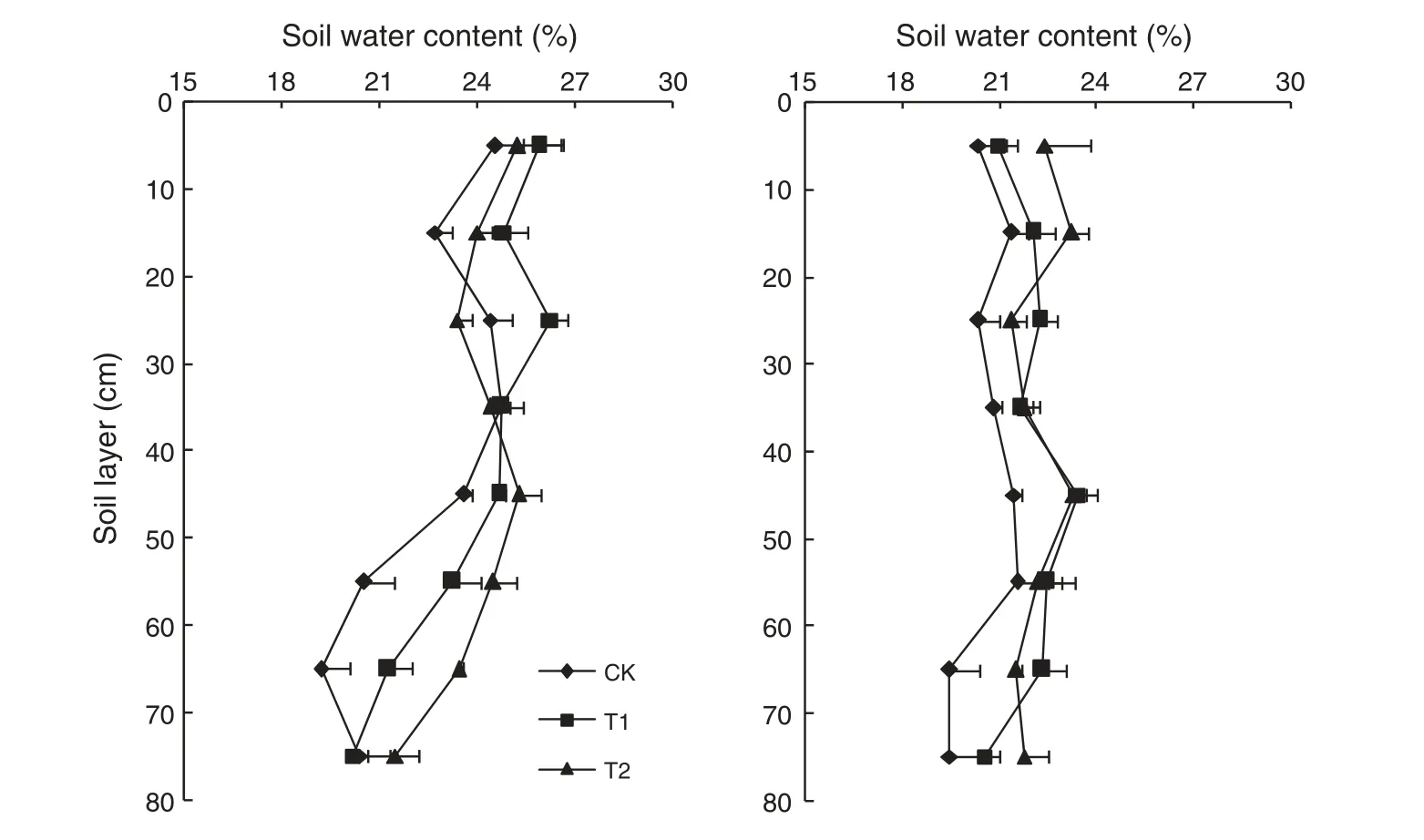
Fig.6-Soil water content in the 0-80 cm soil layer under different subsoiling treatments.Left:12-leaf stage;right:early filling stage.
Significant differences in soil OlsenP under the three treatments were found in the 0–40 cm soil layer,whereas the content was not different across treatments in the lower 40 cm soil layer (Fig.8).At the 12-leaf stage,the maximum value under CK treatment was 33.1 mg kg-1in the top 0–10 cm soil layer.At the early filling stage,the content of OlsenP under CK treatment was substantially decreased,given that roots were distributed mainly in the 20–30 cm top soil layer,which the OlsenP content under CK treatment was markedly higher than those under the subsoil tillage treatments.Up to the 40–80 cm soil layer,readily available phosphorus reached its maximum at the 12-leaf stage under CK treatment,whereas at the early filling stage,no significant differences were found among three treatments.
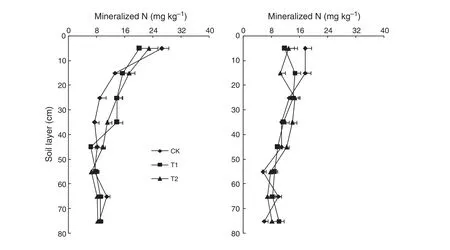
Fig.7-Mineralized nitrogen in the 0-80 cm soil layer under different subsoiling treatments.Left:12-leaf stage;right:early filling stage.
4.Discussion
A tillage method is an important management strategy in an agricultural production system [30].In recent years,soil management dominated by small-sized four-wheeled tractors has resulted in soil compaction,severe soil water shortage,and soil degradation [3,5].Our four-year study indicated that inter tillage and subsoiling loosen the soil,break up the plow pan caused by multiyear conventional soil management,and enhance root penetration to depth.Subsoil tillage management also reduces soil bulk density[22,28],deepens the active soil layer,and effectively increases soil water storage capacity[15,31].After subsoiling tillage,the proportions of root length and surface area in deeper soil were significantly increased,especially under subsoil tillage to 50 cm (Figs.2–3),owing largely to the increased depth of the subsoil,which promotes root proliferation during the growing season.Two main contributions are root length and root diameter,which result in increased root surface for water and nutrient absorption[32].Dai et al.[33]emphasized that the root distribution under the plow pan may also play a key role in the uptake and utilization of nutrients and water in deep soil,especially after flowering,for the reason that the active layer for nutrient uptake by the root system is then below the 30 cm soil layer[34].At the early filling stage,the uptake capacities for nutrients and water in the soil under the subsoil tillage treatments were greater than that under the CK treatment(Table 3,Fig.6).Subsoil tillage also had positive effect on soil moisture,especially in deep soil,and soil water content was significantly increased below 40 cm,even during a dry season(Fig.S1).Thus,subsoil tillage not only enhances soil water storage capacity but enhances crop uptake of nutrients and water,increasing grain weight [21] and ultimately,grain yield of maize[35,36].

Fig.8-Olsen-P in the 0-80 cm soil layer under different subsoiling treatments.Left:12-leaf stage;right:early filling stage.
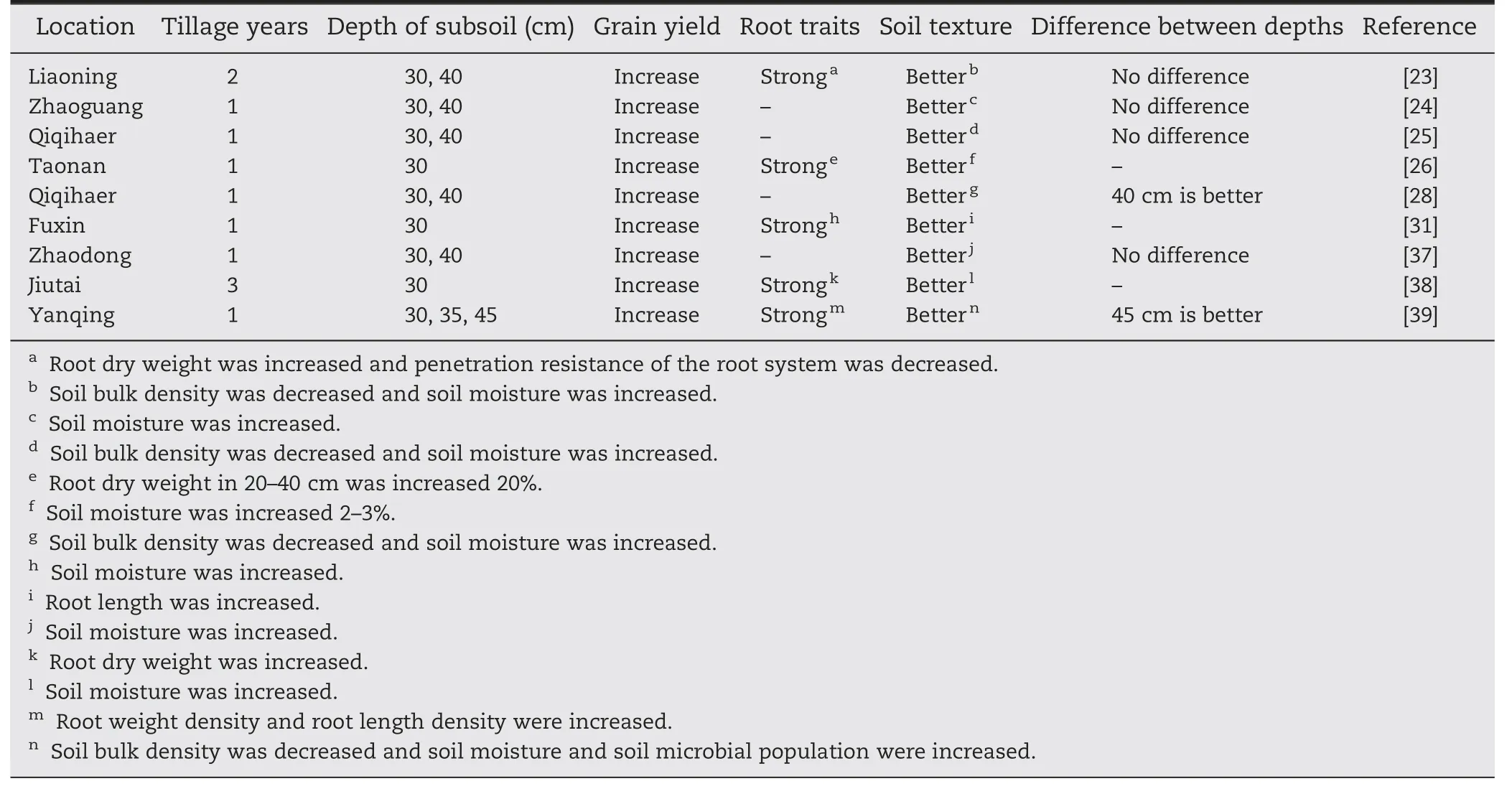
Table 5-Effect of subsoiling tillage on grain yield,root system,and soil properties in northeastern China.
The depth of subsoiling is an important cost consideration for farmers.Most of the published papers concerning northeastern China were reviewed and the results suggested no significant difference between 30 and 40 cm subsoiling depths(Table 5).Most studies have been performed over a single year with too-small differences in subsoiling depth to reflect the actual situation.In the present study,no significant differences were observed in N,P,and K accumulations,biomass,yield and components in maize under different subsoil tillage treatments except in 2012.Environment(year)and interaction with subsoiling treatment showed a significant effect on nutrient uptake,plant growth,and grain yield (Table 1).An accurate evaluation of subsoil tillage should be obtained by a long term experiment[15].However,the deeper the subsoiling layer,the more roots developed in deeper soil under the T2 treatment,and root diameter under the T2 treatment was significantly higher than that under the T1 treatment.Our analysis suggests that subsoil tillage as deep as the 50 cm soil layer improves soil physical behavior and reduces soil mechanical resistance to root penetration [22].More importantly,the aboveground stability of plants is enhanced by a well-developed root system.The experiment field experienced Typhoon Bolaven around August 30,2012,and the lodging rates of plants under the CK,T1 and T2 treatments were 14.8%,4.7%,and 0,respectively.Thus lodging resistance and resistance to environmental stress in maize can be markedly improved by deep subsoil tillage,an advantage to be weighed in view of the trend of increasingly frequent natural disasters in the recent years.
5.Conclusion
Inter tillage and subsoiling loosened the soil,significantly increased root length,surface area,dry weight,and diameter,and increased the proportion of roots in the 40–80 cm soil layer.The advantages of inter tillage and subsoiling were the delivery of sufficient nutrients for plant growth,facilitation of N,P,and K accumulations in aboveground plant parts,increase in grain weight,and ultimate increase in maize yield.Moreover,subsoiling to increased depths may improve maize root morphology and resistance to environmental stress,especially lodging resistance.
This study was supported by the National Key Technology R&D Program of China (2012BAD04B02,2013BAD07B02,and 2011BAD16B10),the Special Fund for Agro-Scientific Research in the Public Interest (201103003 and 201303126-4),and the Key Technology R&D Program of Jilin province,China(20126026).
Supplementary material
Supplementary material to this article can be found online at http://dx.doi.org/10.1016/j.cj.2014.04.006.
[1] MOA (Ministry of Agriculture),China Agricultural Yearbook,China Agricultural Press,Beijing (China),2012.
[2] C.T.Wang,S.K.Li,Assessment of limiting factors and techniques prioritization for maize production in China,Agric.Sci.China 43(2010)1136–1146(in Chinese with English abstract).
[3] L.P.Zhao,H.B.Wang,H.Q.Liu,Y.L.Wang,S.X.Liu,Y.Wang,Mechanism of fertility degradation of black soil in corn belt of Songliao plain,Acta Pedol.Sin.43(2006) 79–84(in Chinese with English abstract).
[4] L.P.Zhao,Z.D.Zhang,H.B.Wang,Q.Gao,Y.Wang,S.H.Wang,J.Feng,S.X.Liu,H.Q.Liu,Q.F.Zheng,Fertility evolution characteristics and fertilizing technologies of black soil in the corn belt of the Songliao plain,J.Jilin Agric.Univ.30(2008)511–516 (in Chinese with English abstract).
[5] L.C.Wang,H.Ma,J.Y.Zheng,Research on rational plough layer construction of spring maize soil in northeast China,J.Maize Sci.16(2008)13–17(in Chinese with English abstract).
[6] H.B.Wang,L.M.Chen,L.P.Zhao,H.Q.Liu,Y.Wang,Influence of present farming system of corn belt on fertility degradation in Jilin province,Trans.CSAE 25 (2009) 301–305(in Chinese with English abstract).
[7] S.H.Zhang,S.K.Li,Domestic and Foreign Corn Industrial Technology Development Report,China Agricultural Science and Technology Press,Beijing,2010.
[8] Y.Z.Wang,W.Y.Li,Z.R.Yin,Progress in relationship both maize root and its yields,J.Jilin Agric.Sci.24(1999) 6–8(in Chinese with English abstract).
[9] J.He,H.W.Li,H.W.Gao,Subsoiling effect and economic benefit under conservation tillage mode in northern China,Trans.CSAE 22(2006) 62–67(in Chinese with English abstract).
[10] H.L.Qin,W.S.Gao,Y.C.Ma,L.Ma,Effects of subsoiling on soil moisture under conservation tillage mode,Agric.Sci.China 41(2008) 78–85(in Chinese with English abstract).
[11] X.J.Yang,C.J.Li,Impacts of mechanical compaction on soil properties,growth of crops,soil-borne organisms and environment,Agric.Sci.China 41 (2008) 2008–2015(in Chinese with English abstract).
[12] M.Huang,Y.J.Li,J.Z.Wu,M.C.Chen,J.K.Sun,Effects of subsoiling and mulch tillage on soil properties and grain yield of winter wheat,J.Henan Univ.Sci.Technol.27(2006) 74–77(in Chinese with English abstract).
[13] E.H.Wang,X.W.Chen,Effect of heavy machinery operation on soil three phases and available nutrient in Phaeozem region,J.Soil Water Conserv.21 (2007) 98–102 (in Chinese with English abstract).
[14] K.L.Ding,M.J.Hann,Influences of subsoiling on physical characters of soil water storage capacity and plant growth,China Rural Water Hydropower 11 (1997) 13–17(in Chinese with English abstract).
[15] S.D.Evans,M.J.Lindstrom,W.B.Voorhees,J.F.Moncrief,G.A.Nelson,Effect of subsoiling and subsequent tillage on soil bulk density,soil moisture,and corn yield,Soil Tillage Res.38(1996) 35–46.
[16] L.C.Wang,S.F.Bian,J.Ren,W.R.Liu,Study on technique way to increase unit area yield in the main production zone of spring maize,J.Maize Sci.15 (2007) 133–134 (in Chinese with English abstract).
[17] D.Sidhu,S.W.Duiker,Soil compaction in conservation tillage: crop impacts,Agron.J.98(2006) 1257–1264.
[18] N.H.Abu-Hamdeh,Compaction and subsoiling effects on corn growth and soil bulk density,Soil Sci.Soc.Am.J.67(2003) 1213–1219.
[19] R.Song,C.S.Wu,J.M.Mu,K.Z.Xu,Effect of subsoiling on root growth of maize,J.Jilin Agric.Univ.22(2000) 73–75(in Chinese with English abstract).
[20] Y.J.E,J.Y.Dai,W.L.Gu,Studies on the relationship between root growth and yield in maize,Acta Agron.Sin.14(1988)149–154 (in Chinese with English abstract).
[21] H.Qi,M.Liu,W.J.Zhang,Z.P.Zhang,X.F.Li,Z.W.Song,J.L.Yu,Y.N.Wu,Effect of deep loosening mode on soil physical characteristics and maize root distribution,Acta Agric.Boreali-Occid.Sin.27(2012)191–196(in Chinese with English abstract).
[22] E.C.Varsa,S.K.Chong,J.O.Abolaji,D.A.Farquhar,F.J.Olsen,Effect of deep tillage on soil physical characteristics and corn(Zea mays L.) root growth and production,Soil Tillage Res.43(1997) 219–228.
[23] J.B.Xiao,Z.X.Sun,J.T.Yang,Y.L.Zhang,J.M.Zhen,Y.Liu,Effect of subsoiling on soil water and crop yield in semi-arid area,Chin.J.Soil Sci.42(2011) 709–713 (in Chinese with English abstract).
[24] H.J.Chen,S.Y.Gong,J.L.Li,Z.F.Zhang,F.Z.Chen,Y.F.Zhang,Effect of different subsoiling patterns on the yield and soil moisture for early spring maize,Heilongjiang Agric.Sci.10(2011)18–20(in Chinese with English abstract).
[25] Y.T.Liu,Y.X.Wang,S.Q.Zhang,L.H.Zheng,H.Y.Yang,L.Liu,Y.L.Lian,Effects of different subsoiling patterns on soil moisture and growth of maize,Heilongjiang Agric.Sci.5(2012) 20–24 (in Chinese with English abstract).
[26] S.F.Bian,H.Ma,F.Xue,S.Yang,G.B.Tan,Research of subsoiling technology in conservation tillage in semi-arid area of Jilin province,J.Maize Sci.8(2000) 67–78(in Chinese with English abstract).
[27] Q.Q.Meng,J.G.Xie,H.J.Hu,X.C.Wang,X.F.Wang,W.Wu,Effects of subsoiling treatments on maize yield and its component factors,J.Jilin Agric.Sci.25(2000) 25–28(in Chinese with English abstract).
[28] J.H.Wang,X.J.Gong,Y.Yu,Y.Zhao,Y.B.Jiang,C.R.Qian,Effects of spring subsoiling on soil physical characters and maize yield,Heilongjiang Agric.Sci.12(2011) 16–18(in Chinese with English abstract).
[29] S.D.Bao,Soil Agricultural Chemical Analysis,China Agriculture Press,Beijing,2000.257–270 (in Chinese).
[30] Y.Xiong,Q.Xu,X.L.Yao,Z.L.Zhu,Effect of soil tillage systems on soil fertility,Acta Pedol.Sin.17(1980) 101–119(in Chinese with English abstract).
[31] X.Z.Wang,L.C.Qiu,Influence of subsoiling to moisture of soil and root growth of maize,J.Shenyang Agric.Univ.42(2011)630–633 (in Chinese with English abstract).
[32] W.G.Liu,L.Shan,X.P.Deng,Effects of soil bulk density on the growth of maize root system under different water condition,Acta Bot.Boreal-Occident.Sin.22(2002) 831–838 (in Chinese with English abstract).
[33] J.Y.Dai,Y.J.E,W.L.Gu,Studies on the relationship between root growth and yield in maize(Zea mays L.),Acta Agron.Sin.14(1988) 310–314 (in Chinese with English abstract).
[34] X.D.Zhu,Y.T.Liu,Study on maize root activity and its space distribution in soil,Acta Agric.Nucl.Sin.3(1982) 17–22(in Chinese with English abstract).
[35] C.H.Li,S.L.Li,Q.Wang,S.P.Hao,J.F.Han,A study on corn root growth and activities at different soil layers with special bulk density,Agric.Sci.China 38(2005)1706–1711(in Chinese with English abstract).
[36] C.H.Li,P.P.Mei,Q.Wang,S.P.Hao,Influences of soil bulk density in deep soil layers on the uptake and redistribution of nitrogen,phosphorous and potassium in maize,Agric.Sci.China 40(2007) 1371–1378(in Chinese with English abstract).
[37] W.Zhao,Effects of different subsoiling treatments on maize yield and its component factors,Heilongjiang Agric.Sci.12(2011) 35–37(in Chinese with English abstract).
[38] J.Huang,A.W.Wang,Y.R.Zhang,Y.Cao,F.Xue,Effects of new cropping system on soil properties of wide and narrow spacing maize rotation planting,stripe deep loosening and leaving high stubble on the ground,Chin.J.Soil Sci.33(2002)168–171 (in Chinese with English abstract).
[39] J.F.Liang,Q.Z.Qi,X.H.Jia,S.J.Gong,Y.F.Huang,Effects of different tillage managements on soil properties and corn growth,Ecol.Environ.Sci.19(2010) 945–950 (in Chinese with English abstract).
- The Crop Journal的其它文章
- Productivity,quality and soil health as influenced by lime in ricebean cultivars in foothills of northeastern India
- Genotype × environment interaction effects on early fresh storage root yield and related traits in cassava
- Identification of QTL for adult-plant resistance to powdery mildew in Chinese wheat landrace Pingyuan 50
- Isolation and characterization of a novel wall-associated kinase gene TaWAK5 in wheat(Triticum aestivum)
- Exp2 polymorphisms associated with variation for fiber quality properties in cotton(Gossypium spp.)
- The impacts of conservation agriculture on crop yield in China depend on specific practices,crops and cropping regions

